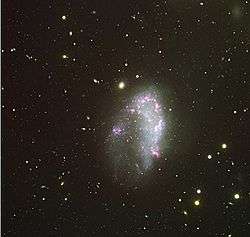NGC 1427A
NGC 1427A is an irregular galaxy in the constellation Eridanus. Its distance modulus has been estimated using the globular cluster luminosity function to be 31.01 ± 0.21 which is about 52 Mly.[2] It is the brightest dwarf irregular member of the Fornax cluster and is in the foreground of the cluster's central galaxy NGC 1399.[2]
| NGC 1427A | |
|---|---|
.jpg) Hubble Space Telescope image of NGC 1427A | |
| Observation data (J2000 epoch) | |
| Constellation | Eridanus |
| Right ascension | 3h 40m 9.3s[1] |
| Declination | −35° 37′ 28″[1] |
| Redshift | 2028 ± 1 km/s[1] |
| Distance | 51.9+5.3 −4.7 Mly (15.9+1.6 −1.4 Mpc)[2] |
| Apparent magnitude (V) | 13.4[1] |
| Characteristics | |
| Type | IB(s)m[1] |
| Apparent size (V) | 2′.3 × 1′.5[1] |
| Other designations | |
| PGC 13500[1] | |
Characteristics and fate

NGC 1427A is over 20,000 light-years long and similar to the Large Magellanic Cloud. The resulting pressure is giving the galaxy its arrowhead outline and triggering the beautiful but violent episodes of star formation.
Under the influence of galactic tides, NGC 1427A is travelling into the center of the Fornax cluster with a velocity of approximately 600 km per second. Its distinctive arrowhead shape has been formed by this rapid, upwards movement. The interaction of NGC 1427A with Fornax gasses and galaxies during its journey will cause the disruption of the galaxy within the next billion years, an event which was common during the evolution of the Universe but has become increasingly rare.[3][4]
Image
The Hubble Space Telescope's Advanced Camera for Surveys was used to obtain images of NGC 1427A in visible (green), red, and infrared filters in January 2003. These images were then combined by the Hubble Heritage team to create the color image shown in box. Astronomers are using the data to investigate the star-formation patterns throughout the object, to verify a prediction that there should be a relation between the ages of stars and their positions within the galaxy. This will help them understand how the gravitational influence of the cluster has affected the internal workings of this galaxy, and how this galaxy has responded to passing through the cluster environment. This image was image of the day on March 4, 2005.[5]
Background spiral galaxy
To the upper left of NGC 1427A is a background galaxy that happens to lie near Hubble's line of sight but is some 25 times further away, about 1.3 billion light-years away. In contrast to the irregularly shaped NGC 1427A, the background galaxy is a magnificent spiral, somewhat similar to our own Milky Way. Stars are forming in its symmetric pinwheel-shaped spiral arms, which can be traced into the galaxy's bright nucleus. This galaxy is, however, less dominated by very young stars than NGC 1427A, giving it an overall yellower color. At even greater distances background galaxies of various shapes and colors are scattered across the Hubble image. [6]
References
- "NASA/IPAC Extragalactic aDatabase". Results for NGC 1427a. Retrieved 2007-04-21.
- Georgiev, Iskren Y.; Hilker, Michael; Puzia, Thomas H.; Chanamé, Julio; Mieske, Steffen; Goudfrooij, Paul; Reisenegger, Andreas; Infante, Leopoldo (June 2006). "The old globular cluster system of the dIrr galaxy NGC 1427A in the Fornax cluster". Astronomy and Astrophysics. 452 (1): 141–153. arXiv:astro-ph/0602263. Bibcode:2006A&A...452..141G. doi:10.1051/0004-6361:20064880.
- Administrator, NASA Content (2017-02-07). "The Impending Destruction of NGC 1427A". NASA. Retrieved 2018-04-20.
- "NGC 1427A, an irregular galaxy in Eridanus". Anne's Astronomy News (in Dutch). 2013-02-23. Retrieved 2018-04-20.
- https://apod.nasa.gov/apod/ap050304.html
- https://hubblesite.org/image/1662/gallery